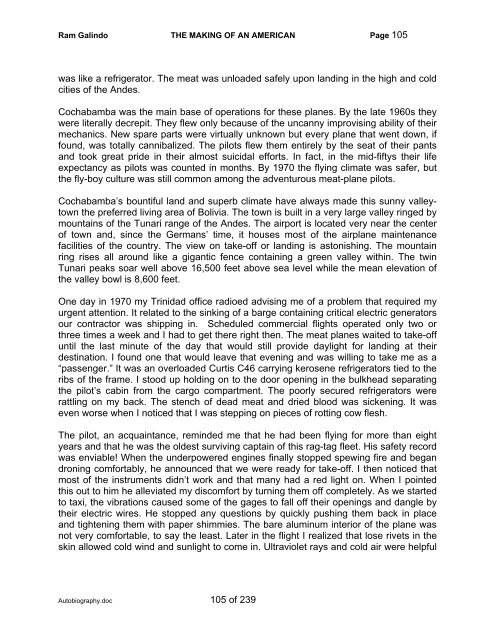Autobiography - The Galindo Group
Autobiography - The Galindo Group
Autobiography - The Galindo Group
You also want an ePaper? Increase the reach of your titles
YUMPU automatically turns print PDFs into web optimized ePapers that Google loves.
Ram <strong>Galindo</strong> THE MAKING OF AN AMERICAN Page 105<br />
was like a refrigerator. <strong>The</strong> meat was unloaded safely upon landing in the high and cold<br />
cities of the Andes.<br />
Cochabamba was the main base of operations for these planes. By the late 1960s they<br />
were literally decrepit. <strong>The</strong>y flew only because of the uncanny improvising ability of their<br />
mechanics. New spare parts were virtually unknown but every plane that went down, if<br />
found, was totally cannibalized. <strong>The</strong> pilots flew them entirely by the seat of their pants<br />
and took great pride in their almost suicidal efforts. In fact, in the mid-fiftys their life<br />
expectancy as pilots was counted in months. By 1970 the flying climate was safer, but<br />
the fly-boy culture was still common among the adventurous meat-plane pilots.<br />
Cochabamba’s bountiful land and superb climate have always made this sunny valleytown<br />
the preferred living area of Bolivia. <strong>The</strong> town is built in a very large valley ringed by<br />
mountains of the Tunari range of the Andes. <strong>The</strong> airport is located very near the center<br />
of town and, since the Germans’ time, it houses most of the airplane maintenance<br />
facilities of the country. <strong>The</strong> view on take-off or landing is astonishing. <strong>The</strong> mountain<br />
ring rises all around like a gigantic fence containing a green valley within. <strong>The</strong> twin<br />
Tunari peaks soar well above 16,500 feet above sea level while the mean elevation of<br />
the valley bowl is 8,600 feet.<br />
One day in 1970 my Trinidad office radioed advising me of a problem that required my<br />
urgent attention. It related to the sinking of a barge containing critical electric generators<br />
our contractor was shipping in. Scheduled commercial flights operated only two or<br />
three times a week and I had to get there right then. <strong>The</strong> meat planes waited to take-off<br />
until the last minute of the day that would still provide daylight for landing at their<br />
destination. I found one that would leave that evening and was willing to take me as a<br />
“passenger.” It was an overloaded Curtis C46 carrying kerosene refrigerators tied to the<br />
ribs of the frame. I stood up holding on to the door opening in the bulkhead separating<br />
the pilot’s cabin from the cargo compartment. <strong>The</strong> poorly secured refrigerators were<br />
rattling on my back. <strong>The</strong> stench of dead meat and dried blood was sickening. It was<br />
even worse when I noticed that I was stepping on pieces of rotting cow flesh.<br />
<strong>The</strong> pilot, an acquaintance, reminded me that he had been flying for more than eight<br />
years and that he was the oldest surviving captain of this rag-tag fleet. His safety record<br />
was enviable! When the underpowered engines finally stopped spewing fire and began<br />
droning comfortably, he announced that we were ready for take-off. I then noticed that<br />
most of the instruments didn’t work and that many had a red light on. When I pointed<br />
this out to him he alleviated my discomfort by turning them off completely. As we started<br />
to taxi, the vibrations caused some of the gages to fall off their openings and dangle by<br />
their electric wires. He stopped any questions by quickly pushing them back in place<br />
and tightening them with paper shimmies. <strong>The</strong> bare aluminum interior of the plane was<br />
not very comfortable, to say the least. Later in the flight I realized that lose rivets in the<br />
skin allowed cold wind and sunlight to come in. Ultraviolet rays and cold air were helpful<br />
<strong>Autobiography</strong>.doc 105 of 239


